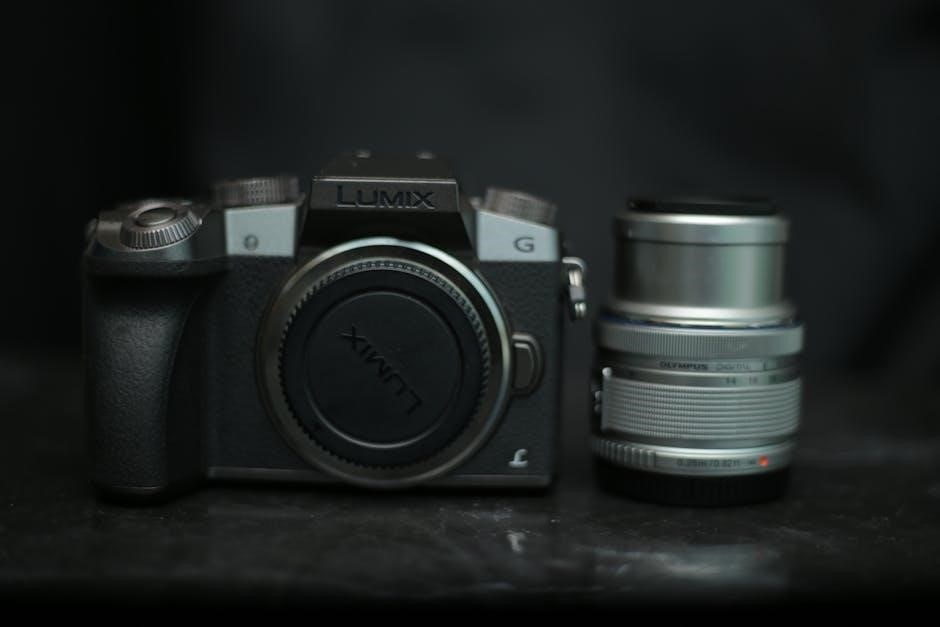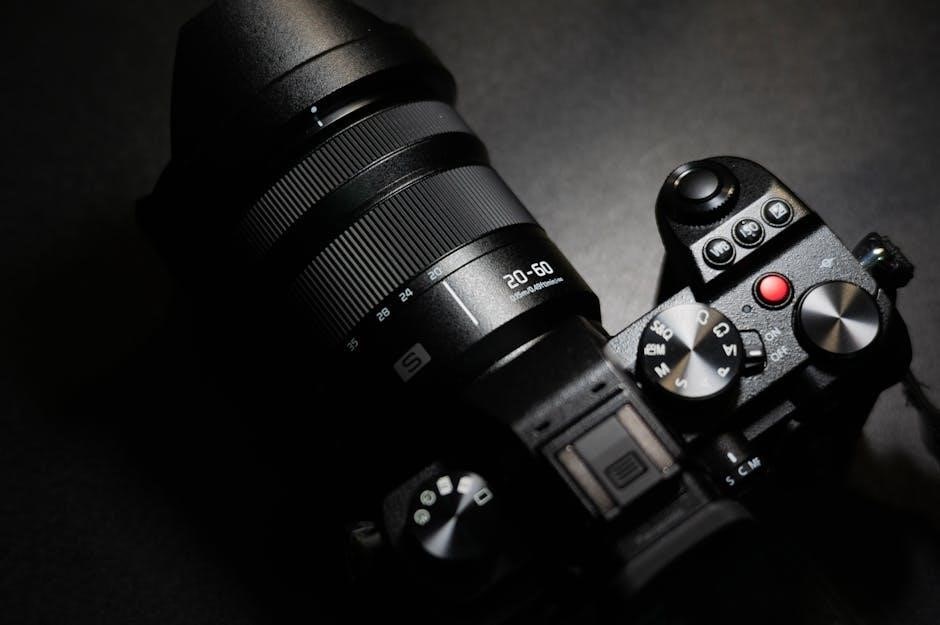Panasonic Lumix FZ300 Manual: A Comprehensive Guide
Welcome! This guide helps you master your Panasonic Lumix FZ300 camera. It compiles resources, operating instructions, and support information to ensure you unlock its full potential. Whether you’re a beginner or experienced photographer, this will help you.
The Panasonic Lumix FZ300 is a versatile bridge camera known for its 24x optical zoom, constant f/2.8 aperture, and robust build. It bridges the gap between point-and-shoot cameras and DSLRs, offering advanced features in a user-friendly package. Its constant aperture ensures consistent performance across the zoom range, making it ideal for various shooting scenarios.
This camera is designed for both beginner and experienced photographers. Its intuitive interface and comprehensive manual controls allow users to explore their creativity. The FZ300’s durable construction makes it suitable for outdoor use, even in challenging weather conditions. It captures high-quality videos and photos, making it a reliable tool.
The Lumix FZ300 boasts features like 4K video recording, image stabilization, and a high-resolution electronic viewfinder. These features enhance the shooting experience and ensure professional-looking results. Its adaptability and performance make it a popular choice for travel, wildlife, and everyday photography. This guide provides comprehensive information to maximize its capabilities.
Whether you’re looking to understand basic operations or delve into advanced settings, this guide will provide you with the information you need to get the most out of your Lumix FZ300.
Basic Operations: Getting Started with Your FZ300
Let’s begin with the fundamentals of operating your Lumix FZ300. First, locate the power button, usually on top of the camera, and press it to turn the device on. The LCD screen will illuminate, displaying the current view. Familiarize yourself with the main dial, often used to switch between shooting modes such as Intelligent Auto (iA), Program (P), Aperture Priority (A), Shutter Priority (S), and Manual (M).

In iA mode, the camera automatically adjusts settings for optimal results. For more control, explore P mode, allowing you to adjust exposure compensation. The A and S modes give you control over aperture and shutter speed, respectively, while M mode offers full manual control over all settings.
To take a photo, gently press the shutter button halfway to focus, then fully press it to capture the image. Use the zoom lever to adjust the focal length. Review your photos by pressing the playback button. Navigating the menu system, accessed via the menu button, allows you to change settings such as image quality, white balance, and ISO.
Understanding these basic operations is crucial for effectively using your Lumix FZ300 and capturing great photos and videos.

Understanding the Camera’s Layout: Buttons, Dials, and Levers
To fully utilize the Lumix FZ300, it’s essential to understand the function of each button, dial, and lever. The top panel houses the mode dial, allowing you to select shooting modes like Intelligent Auto, Program, Aperture Priority, Shutter Priority, Manual, and Custom modes. Adjacent to it, you’ll find the power switch and the shutter button, often integrated with the zoom lever.
The rear of the camera features the LCD screen, providing a live view and playback interface. Surrounding the screen are several buttons: the menu button, accessing camera settings; the display button, toggling on-screen information; the playback button, reviewing captured images and videos; and the delete button, removing unwanted files.

A directional pad, often with a rotating dial, enables navigation through menus and settings, while also providing quick access to functions like ISO, white balance, and focus mode. The side of the lens barrel features a side lever, customizable for functions like zoom control or manual focus. Understanding these controls empowers you to efficiently adjust settings and capture your desired shots with ease.
Navigating the Menu System
The Lumix FZ300’s menu system is the central hub for customizing camera settings and accessing advanced features. To enter the menu, press the ‘Menu’ button located on the rear of the camera. The menu is organized into several tabs, typically including ‘Record,’ ‘Custom,’ ‘Setup,’ and ‘Playback,’ each containing related settings.
Use the directional pad or the rotating dial to navigate between tabs and menu items. Press the ‘OK’ or ‘Set’ button to select an item and access its options. Within each menu item, you can modify settings such as image quality, ISO sensitivity, white balance, focus mode, and metering mode. Submenus may exist for more detailed configurations.
The ‘Custom’ menu allows you to personalize camera functions, such as assigning functions to buttons or customizing display settings. The ‘Setup’ menu includes options for language, date/time, and power-saving settings. Familiarizing yourself with the menu structure will enable you to quickly adjust settings in response to changing shooting conditions. Remember to exit the menu by pressing the ‘Menu’ button again to save your changes.
Advanced Features Manual: Unlocking the FZ300’s Potential
The Lumix FZ300 boasts a wealth of advanced features that extend far beyond basic point-and-shoot functionality. Delving into these capabilities unlocks the camera’s true potential, allowing for creative and technically refined photography.
This section provides a comprehensive guide to mastering these advanced features. Topics include utilizing the full manual mode for complete control over exposure settings like aperture, shutter speed, and ISO. We will explore advanced focusing techniques, including focus peaking and manual focus assist, to achieve pinpoint sharpness.
Furthermore, we will cover the camera’s sophisticated metering modes for accurate exposure in various lighting conditions, as well as custom white balance settings to ensure accurate color rendition. The guide will also address advanced video recording options, such as 4K video, high-speed recording, and external microphone connectivity. By understanding and utilizing these advanced features, you can elevate your photography and videography to a professional level.
Manual Focus Mode: Achieving Sharp Focus
Manual focus mode on the Lumix FZ300 offers precise control over focusing, enabling you to achieve sharpness in situations where autofocus systems might struggle. This is particularly useful for macro photography, low-light scenarios, or when shooting through obstructions.
To engage manual focus, set the focus mode selector on the camera body to MF. The focus ring around the lens allows for fine adjustments. The camera offers focusing aids to assist in achieving critical sharpness. Focus peaking highlights the in-focus areas of the image with a colored outline, making it easier to visually confirm focus.
Additionally, the FZ300 provides a focus magnification feature, which enlarges a portion of the image on the screen, enabling you to scrutinize details and make precise focus adjustments. Combining focus peaking and magnification ensures accurate manual focusing. Practice and experimentation with manual focus will greatly expand your creative control.
Shooting Modes: Selecting the Right Mode for Your Scene
The Lumix FZ300 offers a variety of shooting modes to cater to different photographic scenarios and user preferences. Understanding these modes and selecting the appropriate one is crucial for capturing the best possible images.
Intelligent Auto (iA): This mode is designed for beginners, automatically selecting the optimal settings based on the scene. It’s perfect for everyday snapshots.
Program AE (P): Provides automatic exposure with the flexibility to adjust settings like ISO and white balance.
Aperture Priority (A): Allows you to control the aperture, influencing depth of field, while the camera automatically sets the shutter speed.
Shutter Priority (S): You control the shutter speed, affecting motion blur, while the camera sets the aperture.
Manual (M): Gives complete control over both aperture and shutter speed for maximum creative freedom.
Creative Video Mode: Offers options for creative video recording.
Custom Modes (C1, C2): Allows you to save and quickly access your preferred settings.
Experiment with these modes to understand how they affect your images and find the best options for your desired results.
Customizing Camera Settings: Tailoring the FZ300 to Your Needs
The Panasonic Lumix FZ300 offers a wealth of customizable settings, enabling you to tailor the camera to your specific shooting style and preferences. By delving into the menu system and adjusting these settings, you can optimize your camera’s performance and streamline your workflow.
Function Buttons (Fn): Assign frequently used functions to the Fn buttons for quick access, saving time and enhancing efficiency. This is one of the most useful ways to make the camera your own.
Custom Menus: Create custom menus for frequently used settings.
Drive Mode: Adjust continuous shooting speeds, burst rates, and self-timer options.
Focus Settings: Fine-tune focus area mode, autofocus behavior, and manual focus aids like peaking.
Metering Mode: Select the appropriate metering mode (e.g., multi, center-weighted, spot) to ensure accurate exposure in various lighting conditions.
Image Quality: Adjust image resolution, aspect ratio, and JPEG quality to balance file size and image detail.
White Balance: Set the white balance to match the lighting conditions, ensuring accurate color rendition. You can use presets or custom settings.
ISO Settings: Configure ISO sensitivity to manage noise levels and brightness in different lighting situations.
Troubleshooting Common Issues
Even with careful use, you might encounter issues with your Panasonic Lumix FZ300. This section provides solutions for some common problems.
Camera Won’t Turn On: Ensure the battery is properly inserted and fully charged. Check the battery contacts for dirt or corrosion. If using an AC adapter, verify it’s securely connected.
Image is Blurry: Check the focus mode (AF/MF). If in AF, ensure the focus point is on the subject. In MF, adjust the focus ring until the image is sharp. Also, check for camera shake; use a tripod or increase the shutter speed.
Error Messages: Consult the manual for specific error code meanings. Common errors include memory card issues or lens errors. Try reformatting the memory card (after backing up data) or restarting the camera.
Overexposed/Underexposed Images: Check the metering mode and exposure compensation settings. Adjust accordingly based on the lighting conditions.
Flash Not Firing: Ensure the flash is enabled in the settings. Check for obstructions preventing the flash from firing.
LCD Screen Issues: Adjust the screen brightness. If the screen is completely black, it might indicate a hardware problem.
Zoom Problems: Make sure nothing is obstructing the lens. If the zoom is jerky, try cleaning the lens contacts.
Firmware Updates: Keeping Your Camera Up-to-Date
Updating your Panasonic Lumix FZ300’s firmware is crucial for optimal performance and access to new features. Firmware updates address bugs, improve compatibility, and enhance overall functionality.
Why Update? Firmware updates can resolve performance issues, introduce new features, and improve compatibility with accessories and software. Regularly checking for updates ensures your camera operates at its best.
How to Check for Updates: Visit the official Panasonic support website and navigate to the FZ300’s download page. Check the firmware version listed on the website against the version installed on your camera (found in the camera’s menu).
Updating Process:
- Download the latest firmware from the Panasonic website.
- Format an SD card in your camera.
- Copy the downloaded firmware file to the root directory of the SD card.
- Insert the SD card into your camera.
- Follow the on-screen instructions to initiate the firmware update.
Important Notes:
- Ensure the camera battery is fully charged before starting the update.
- Do not turn off the camera or remove the SD card during the update process.
- If the update fails, consult the Panasonic support website for troubleshooting steps.
Available Resources: Manuals and Support
Navigating the features of your Panasonic Lumix FZ300 can be simplified with the right resources. Fortunately, Panasonic offers a variety of materials to help you understand and utilize your camera to its fullest potential.
Official Manuals: Panasonic provides both a Basic Owners Manual and an Advanced Owners Manual. The Basic Manual covers essential operations, while the Advanced Manual delves into more complex settings and features. Both are available for download on the Panasonic support website in PDF format.
Online Support: The Panasonic support website is a comprehensive hub for assistance. You can find FAQs, troubleshooting guides, firmware updates, and driver downloads. It is a first stop for resolving any issues you might encounter.
Community Forums: Engaging with online communities dedicated to Panasonic Lumix cameras can be invaluable. These forums allow you to connect with other users, share experiences, ask questions, and learn tips and tricks.
Panasonic Customer Service: If you require personalized assistance, Panasonic’s customer service is available via phone, email, or chat. Their representatives can provide technical support, answer inquiries, and guide you through complex settings.
Tutorials and Guides: Numerous online tutorials and guides cater to FZ300 users. These resources often provide visual demonstrations and step-by-step instructions for specific techniques and features;
Finding a Printed Version of the Manual

While digital manuals offer convenience, some users prefer the tangible experience of a printed manual for their Panasonic Lumix FZ300. Fortunately, several options exist to obtain a hard copy.
Amazon and eBay: Online marketplaces like Amazon and eBay frequently list printed versions of the FZ300 user manual. These may be new or used, so carefully review the product description and seller ratings before purchasing.
Used Book Retailers: Websites specializing in used books, such as Abebooks, may also carry printed manuals for the FZ300. These are often more affordable than new copies but may exhibit signs of wear.
Third-Party Manuals: Independent publishers sometimes create user guides for specific camera models. These manuals often provide a more detailed and user-friendly explanation of the camera’s features than the official manual.
Print-on-Demand Services: If you have access to the digital PDF version of the manual, you can utilize print-on-demand services like Staples or FedEx Office to create a printed copy. This allows you to customize the size, paper quality, and binding of the manual.
Check Local Camera Stores: Occasionally, local camera stores may have used manuals available for purchase. Calling ahead to inquire about availability is recommended.
When purchasing a printed manual, ensure it covers the specific FZ300 model you own, as features and settings may vary between different Lumix cameras.

